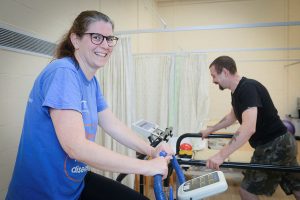Transform the lives of your patients by helping them to run, walk better or simply stand without pain. Prosthetists and Orthotists give back the power of movement to their patients, in a way that’s as pain-free as possible and use the latest technology to create and fit prostheses or aids.
Prosthetists and Orthotists have quite different roles but both aim to improve peoples’ ability to move freely. Prosthetists create and fit artificial replacements for patients who are missing a limb, while Orthotists correct problems or deformities in nerves, muscles and bones with a range of aids.
The roles are quite varied and may include:
- fitting a prosthesis for a military veteran and seeing the full rehabilitation process.
- giving a surgeon your advice when they’re performing an amputation.
- helping a diverse range of ages, from children with cerebral palsy to adults with arthritis.
- preventing a patient from needing an amputation through well-fitting splints and complex footwear.
As a Prosthetist or Orthotist, it’s not just about treating your patients’ physically but helping them feel happy with their blade or brace. You’ll need to be a great communicator and be able build a rapport with your patients. You’ll also need both practical and technical skills and be good at maths. This is a physical job where using your hands is vital as getting the best performance out of a prosthesis or aid can take a lot of adjusting.
Prosthetics
Prosthetists are autonomous registered practitioners who provide gait analysis and engineering solutions to patients with limb loss. They are extensively trained at undergraduate level in mechanics, bio-mechanics, and material science along with anatomy, physiology and pathophysiology.
Their qualifications make them competent to design and provide prostheses that replicate the structural or functional characteristics of the patients absent limb. They are also qualified to modify CE marked prostheses or componentry taking responsibility for the impact of any changes.
They treat patients with congenital loss as well as loss due to diabetes, reduced vascularity, infection and trauma.
Military personnel are forming an increasing part of their caseload. Whilst they are autonomous practitioners they usually work closely with physiotherapists and occupational therapists as part of multidisciplinary amputee rehabilitation teams.
Orthotics
Orthotists are autonomous registered practitioners who provide gait analysis and engineering solutions to patients with problems of the neuro, muscular and skeletal systems.
They are extensively trained at undergraduate level in mechanics, bio-mechanics, and material science along with anatomy, physiology and pathophysiology.
Their qualifications make them competent to design and provide orthoses that modify the structural or functional characteristics of the patients’ neuro-muscular and skeletal systems enabling patients to mobilise, eliminate gait deviations, reduce falls, reduce pain, prevent and facilitate healing of ulcers.
They are also qualified to modify CE marked Orthoses or componentry taking responsibility for the impact of any changes.
They treat patients with a wide range of conditions including Diabetes, Arthritis, Cerebral Palsy, Stroke, Spina Bifida, Scoliosis, MSK, sports injuries and trauma. Whilst they often work as autonomous practitioners they increasingly often form part of multidisciplinary teams such as within the diabetic foot team or neuro-rehabilitation team.
 In this section
In this section